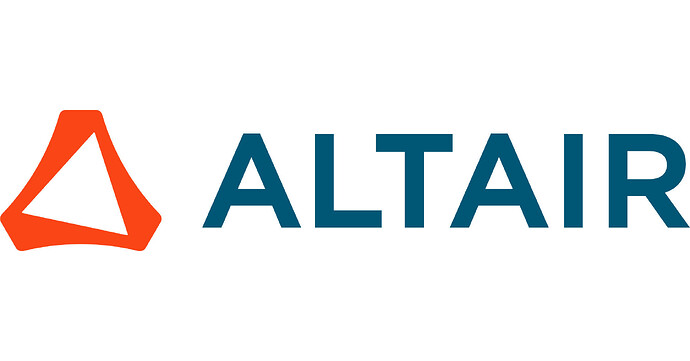Altair Engineering: A Look at Its Growth, Technologies, and Acquisitions
Altair went public in 2017, with a share price of $16, a share capital of 12 million, and a market capitalization of around $200 million. By 2024, the total share capital had increased to 85 million, the share price reached $104, and the price-to-earnings (P/E) ratio surged to 270, whereas the P/E ratio of competitors is generally around 50. This rise is not entirely explained by their products, technologies, or business models. Furthermore, Altair’s AI technologies and products do not stand out in the current leading AI field.
When talking about Altair, one cannot ignore the mention of a key component: Pre-processors.
The three core modules of industrial simulation software are:
- Pre-processor + Solver + Post-processor
Altair’s flagship product and origin is HyperMesh, a universal pre-processor born in 1985, which remains one of the leading products in the market. Its main functions include importing geometry, cleaning and repairing geometry, meshing, and then exporting the mesh for the solver. A detailed explanation has been covered extensively in earlier posts, so there’s no need to elaborate further.
Many might ask, do traditional solvers like ANSYS and NASTRAN, which already have pre-processors, still have room for market expansion? This brings us to the most painful task for traditional simulation engineers: meshing.
The ideal situation is: the mesh is successfully created once, and the simulation converges successfully.
However, the reality is that many times the mesh cannot be created or is created incorrectly. The reasons include geometric errors, improper parameter settings, limitations of mesh algorithms, and conflicting constraints. Even if the mesh is successfully created, issues like mesh distribution and mesh quality can prevent the solver from calculating or cause errors. Generally, pre-processors built into simulation software are insufficient for dealing with these issues.
This is where universal pre-processors come into play. They clean and repair the geometry, and if there are errors in the mesh, they can also be manually fixed through the pre-processor. Especially in complex scenarios, universal pre-processors are more adept at handling various real-world situations. While major simulation software vendors have continually enhanced pre-processor functions, more of their focus remains on solver algorithms.
Universal pre-processors support exporting the solver model into various solver formats. As a result, good pre-processor vendors can easily expand their simulation business, as has been proven by companies like ANSA and HyperMesh.
Altair’s early focus was on topology optimization, with its product OptiStruct. Simply put, it involves designing structures with minimal material usage while maintaining high performance under various constraints. OptiStruct has its own structural solver and also supports various third-party solvers.
Later, the HyperWorks suite emerged, which includes post-processors like HyperView, multi-disciplinary optimization tools like HyperStudy, and HyperGraph. HyperMesh and HyperView have been essential in my own learning.
Altair has acquired around 40 companies throughout its history, and a few of them are worth mentioning:
- EMSS - Main product: FEKO
EMSS was established in the early 1990s in South Africa. Under the leadership of Dr. Gronum Smith, EMSS successfully introduced the Method of Moments (MOM) in the 1980s, and later incorporated the Multi-Level Fast Multipole Method (MLFMM) into FEKO, which became the first commercial software to bring this method to market. FEKO supports both Finite Element Methods (FEM) and hybrid solvers combining MLFMM and FEM, making it suitable for solving large electrical problems in heterogeneous media. - RADIOSS
RADIOSS, developed by a French company, is an explicit dynamics solver. Altair acquired it in 2007. In 2022, RADIOSS became one of the few solvers to go open-source, which made big news in the industry. - SimLab
Altair acquired SimLab in 2010. SimLab is another pre-processor, primarily used in the complex automotive pre-processing field. It overlaps with HyperMesh, but the software’s user interface and operational philosophy are entirely different. Personally, I think the user experience design (UED) of SimLab is superior, enabling users to achieve functionality with fewer clicks. - SolidThinking
SolidThinking is an Italian company’s product, a design software that can be understood as a traditional CAD tool but integrates design, optimization, and simulation capabilities, reflecting the long-standing concept of CAD/CAE seamless integration.
After going public in 2017, Altair received funding that accelerated the company’s acquisitions.
- SimSolid
This product, which uses a meshless method, was introduced earlier. Compared to traditional FEM methods, it reduces computational time by 1-2 orders of magnitude. SimSolid is currently focused on structural applications, with plans to expand into electromagnetics. If it can reduce computational times in the electromagnetic domain by 1-2 orders of magnitude, it could dominate the field and make a significant impact on the EDA sector. - DEM Solutions
Altair acquired a Discrete Element Method (DEM) software product from a UK company, another well-known product in this space being Rocky, acquired by ANSYS from a Brazilian company. DEM is a numerical method used to compute the movement of particles under certain conditions.
Altair has also acquired several small companies in the EDA and electromagnetic fields, as well as those in big data, smart business, 3D printing, and AEC (Architecture, Engineering, and Construction). This shows the wide scope of its business.
In summary, a few key points:
- ANSYS’s acquisition stirred up a lot of activity in the industry.
- Money has been made, US dollar liquidity is high, and stock prices have surged.
- AI today is not the same as what’s to come.
- The second phase of AI development will likely lead to mass layoffs in the tech sector, though the effects in the industrial software industry will be delayed.
- The moat around large industrial software companies is shrinking, and competition between the big players will intensify.
